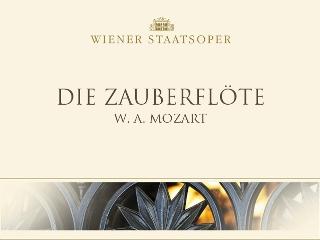Wolfgang Amadeus Mozart - Die Zauberflöte (Wien 2013)
Wolfgang Amadeus Mozart - Die Zauberflöte (Wien 2013)

1. Akt I 2. Akt II Brindley Sherratt - Sarastro Benjamin Bruns - Tamino Olga Pudova - Königin der Nacht Chen Reiss - Pamina Markus Werba - Papageno Alfred Sramek - Sprecher / 2. Priester Benedikt Kobel - 1.Priester Olga Bezsmertna - 1. Dame Christina Carvin - 2. Dame Alisa Kolosova - 3. Dame Valentina Nafornita - Papagena Thomas Ebenstein - Monostatos Marian Talaba - 1. Geharnischter Dan Paul Dumitrescu - 2. Geharnischter Wiener Sängerknaben - 3 Knaben Chor der Wiener Staatsoper Orchester der Wiener Staatsoper Christoph Eschenbach – conductor Aufzeichnung Wiener Staatsoper 30.11.2013
Dancing teddy bears, a larger-than-life Sarastro, live birds and numerous airborn characters all make the brand new production of Mozart’s beloved Singspiel at the Staatsoper a very family-friendly event. Directorial team Mosche Leiser and Patrice Caurier gave the audience some entertaining moments in an evening that was fun if not uniformly successful.
The production is deceptively tricky from a technical perspective. Papageno’s birds are real, with the droppings to prove it. The three boys float around carrying a table laden with food in the second act, then float off into the heavens with Pamina after saving her from suicide by whacking her with a teddy bear. The Queen of the Night’s exit after “Der Hölle Rache” brings down a dozen chairs, and the bread and water offered Papageno are unceremoniously tossed at him from on high. Tamino’s tooting of the (floating) magic flute brings an assortment of humongous stuffed animals into action including a King Kong-style gorilla, two fuzzy teddy bears, a dragon, a rhinoceros and a pair of jogging ostriches. Both Papageno’s hair and glockenspiel move with minds of their own, and dry ice, pyrotechnics and smoke bombs are used in abundance. At one point a group of Austrian policemen accompanied by Monostatos suddenly sprout tutus and dance themselves off stage to chuckles from the audience.
There are also some very inventive costumes. The three ladies are a study in texture and layering in colorful velvet, lace, sequins, jeans, cowboy boots and feathered hats, bringing to mind little girls playing dress-up. Papageno is in a yellow suit, reddish feathers escaping from his beneath his jacket and from the bottom of his trousers. Tamino looks like a character from the Arabian Nights in white harem pants, a blue shirt and yellow sash, and the Queen of the Night is clad in a red satin gown. The Three Boys make their first entrance on a hobby horse dressed like Peter Pan’s “Lost Boys”.
Unfortunately, throughout the evening one had the feeling that the direction and design were not thought through completely. Most of the pyrotechnics are a lot of risk for little effect. Also, even though we do not expect the Staatsoper to have the stunt capabilities of Broadway, I don’t know if the lines attached to Pamina and the Three Boys need to be expressly lit to make it impossible to miss that they are about to be lifted into the air.
The costumes are also incongruous. For all the charm of the Three Ladies’ garb, the inhabitants of Sarastro’s realm wear the most standard black/grey suits available, and Monostatos is in a fatsuit and black-face, solidifying the impression that the costume department just gave up at some point. We are meant to understand that the Pamina and Tamino’s completion of Sarastro’s rites signifies their entrance into adulthood. However, it is hard to believe they would willingly choose this dull pack of obsessive hand-shakers (not to mention creepy mafia henchmen) over the bright world of color and fantasy they left behind – or that Pamina would give up her blue princess dress for a mediocre grey suit.
Musically, the evening had its highlights but was also not overwhelmingly convincing. Christoph Eschenbach’s tempi were generally slow and often not at one with the wishes of the singers. There were ensemble issues from the entrance of the three ladies in Act I through the group numbers near the end of Act II, and the Staatsoper Orchestra also seemed to struggle.
The young cast of principles includes Benjamin Bruns (Tamino) who gave a solid showing, as did Brindley Sherratt (Sarastro). I look forward to hearing the beautiful voice of soprano Chen Reiss (Pamina) in other roles. She possesses ringing tones, gorgeous support and legato, but calling on her to handle Schikaneder’s witty dialogues at the Wiener Staatsoper was unwise. Olga Pudova did not have the towering presence we expect from a Queen of the Night, though she negotiated the majority of her stratospheric passages brilliantly. Markus Werba (Papageno) was charismatic, engaging and completely at ease vocally. He stood out throughout the evening. Valentina Nafornită (Papageno) is a bit heavier vocally than I’m accustomed to in the role, but sang well and looks great in yellow feathers, and the three Sängerknaben were spot-on, audible and adorable.
In short, it’s a fun production with charming aspects, but I would surprised to see this Flute magically find a lasting home in the repertory of the “Haus am Ring”. --- bachtrack.com
download: uploaded yandex 4shared mediafire solidfiles mega filecloudio nornar ziddu








